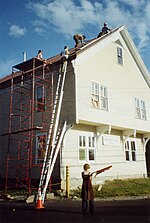Beehive Design Collective
 | |
| Founded | 2000 |
|---|---|
| Focus | resistance to corporate globalization |
| Location | |
Area served | World |
| Method | graphical media |
| Website | beehivecollective.org |

The Beehive Design Collective is a volunteer-driven non-profit art collective that uses graphical media as educational tools to communicate stories of resistance to corporate globalization.[1][2] The purpose of the Machias, Maine-based group is to "cross-pollinate the grassroots"[3][2] by creating collaborative, anti-copyright images that can be used as educational and organizing tools. The most recognizable of these images are large format pen and ink posters, which seek to provide a visual alternative to deconstruction of complicated social and political issues ranging from globalization,[2][4] free trade, militarism,[4] resource extraction, and biotechnology.[2]
Their work has been included in curated exhibitions internationally, including at the Station Museum of Contemporary Art and Manifesta.[5][6] One of their most well-known works, Mesoamérica Resiste, was a nine-year research project working directly with communities in Central America regarding effects of the Mesoamerica Project, and is typical of their community-engaged style of production.[7][8]
Graphic campaigns[edit]
The Collective creates graphic campaigns addressing diverse geo- and socio-political issues. The illustrations are informed and developed through extensive research. The work for the poster began in 2004,[9] and by 2010 the group had distributed over 10,000 posters in the Americas.[2] The most recent campaign in 2012 resulted from travel to Mexico and interviews of a broad spectrum of people. The “Mesoamerica Resiste” poster was used as their aid in this campaign and was unveiled in December 7, 2012 at the Machias Grange Hall. The group adheres to self-imposed rules during their campaign production, including absence of literal human depictions, use of cross-cultural imagery, and avoidance of cultural appropriation.[10] The group bills its pieces as “portable murals,” using them as educational pieces while they travel around the world to do speaking engagements.[9]
The current trilogy in progress details globalization in the western hemisphere through a series of three graphics.[clarification needed]
Storytelling[edit]
The Collective's educational work involves storytelling, international lecture circuits using giant reproductions of their posters as storytelling aids. "Picture lectures" feature a 30-feet high graphic and a 6-foot-tall (1.8 m) fabric flipbook/storybook. Audiences are led through a two-hour interactive, conversational presentation.[11]
Print distribution[edit]
One of the Beehive's goals in their graphic distribution is to have 50% of each print run distributed free to communities in the global south, including to groups working on the issues depicted in the prints.[3] The remaining half are distributed internationally for donations. Posters are distributed at a wide range of venues, events, college campuses and academic events.
All of the Beehive Collective's materials are distributed as anti-copyright,[2] and their production is encouraged for non-profit, non-commercial use to assist in publications and productions. The black and white imagery is designed to facilitate ease of reproduction. The Beehive distributes free clip-art digital imagery via their website and graphic CD-ROMs distributed from their webstore.
Graphic chronology[edit]
- Biodevastation (2000, redux 2002) [2]
- Homogenization Puppeteer (2000) more info
- Free Trade Area of the Americas (2001, redux 2003) [3]
- Plan Colombia (2002, redux 2003) [4][12]
- Latin American Solidarity 2003 Conference (2003) [5]
- Maine Social Forum (2006) [6]
- Biojustice (2007) [7]
- The True Cost of Coal (2010) [8]
- Mesoamérica Resiste (2013) [9]
Machias Valley Grange Hall[edit]

Since the year 2000, the Collective has been engaged in the restoration of the Machias Valley Grange Hall in Machias, Maine,[13] built in 1904. The restoration labor was sourced from visiting volunteers. The building was initially used as the Collective's center of its stone mosaics program.
Annually, the Collective throws a no-cost dress-up dance party of immense proportions called the "Blackfly Ball".[14][15] There are ongoing events such as a weekly Open Mic night and annual Halloween celebration.
In 2007, the Machias Valley Grange Hall was placed onto the National Register of Historic Places.[16]
References[edit]
- ^ "Drawing Common Ground: An Interview with Lara Bee of the Beehive Design Collective". Upping the Anti. 12: 55–71. 2011.
- ^ a b c d e f "Cross-Pollinating the Grassroots: TEN YEARS OF DISMANTLING MONOCULTURE with the Beehive Design Collective". Earth First!. 31 (1). Daily Planet Publishing: 60–63. Winter 2010 – via ProQuest Central.
- ^ a b Libraries, Duke University (2014-10-01). "Pollinating the Grassroots: The Beehive Design Collective". Duke University Libraries Blogs. Retrieved 2020-03-14.
- ^ a b "On the Line". Progressive. 68 (6): 20–23. June 2004 – via MasterFILE Complete.
- ^ Glentzer, Molly (2016-01-29). "Exhibit of works by activist artists is subversive, thoughtful, hilarious". Houston Chronicle. Retrieved 2023-01-18.
- ^ Rawsthorn, Alice (2012-09-09). "In the Shifting World of Product Design, the User Now Has a Voice". The New York Times. ISSN 0362-4331. Retrieved 2023-01-18.
- ^ "Beehive collective to discuss 'Mesoamérica Resiste!' at Bates College Thursday". Press Herald. 2014-03-20. Retrieved 2023-01-18.
- ^ Polinizaciones. "Photo Essay: The Beehive Collective's First Tour in Colombia of the New Graphic Campaign 'Mesoamérica Resiste' – Upside Down World". Retrieved 2023-01-18.
- ^ a b Moretto, Mario (2012-12-09). "Beehive Collective adds giant poster to anti-globalization arsenal". Bangor Daily News. Archived from the original on 2018-07-02. Retrieved 2021-04-12.
- ^ "About Beehive Graphic Campaigns". Archived from the original on 2007-10-26. Retrieved 2007-12-02.
- ^ "Beehive Collective presentation info and presentation schedule". Archived from the original on 2007-12-11. Retrieved 2007-12-02.
- ^ Erler, Carolyn. "Targeting “Plan Colombia”: a Critical analysis of Ideological and Political Visual Narratives by the Beehive Collective and the Drug Enforcement administration Museum." Studies in Art Education 50.1 (2008): 83-97.
- ^ "About the Grange Hall". Archived from the original on 2007-11-21. Retrieved 2007-12-02.
- ^ They had a Ball - Ellsworth American news report on the Machias Blackfly Ball [1]
- ^ "Downeast Coastal Press Eyewitness Account of Blackfly Ball". Archived from the original on 2007-09-21. Retrieved 2007-12-02.
- ^ "(Former) Machias Valley Grange #360, Machias, 1907-1957". Maine Historic Preservation Commission. Archived from the original on 2017-03-13. Retrieved March 12, 2017.


 French
French Deutsch
Deutsch